Read about our public vision for Ontario Place and The Ontario Science Centre and have you, your resident association or your organization Endorse A Better Idea! You/your org will be featured on a list of endorsers on our website! Fill out this form:
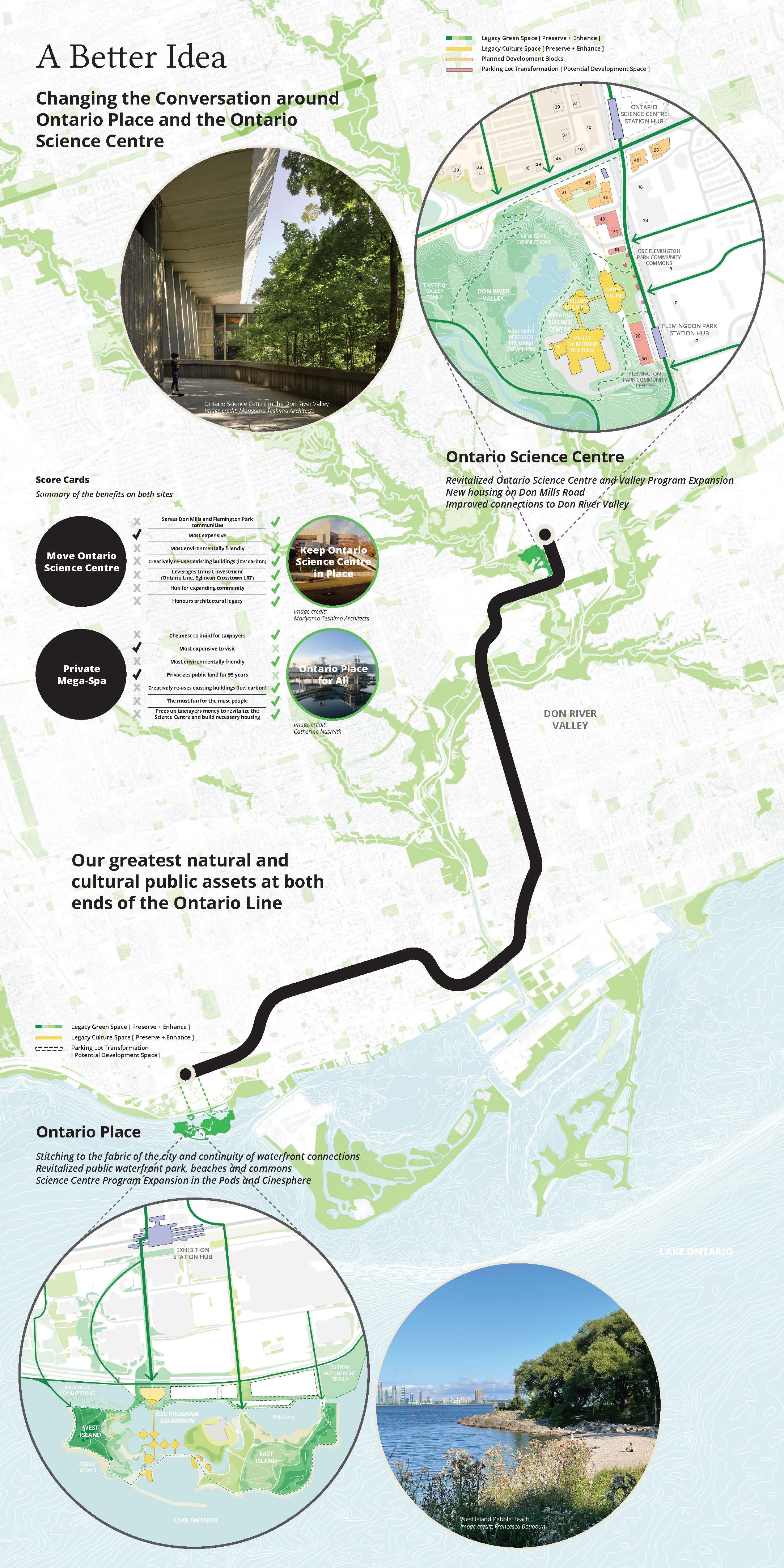

John Robarts, Progressive Conservative Premier of Ontario, 3rd November 1970
A Better Idea
Changing the Conversation around Ontario Place and the Ontario Science Centre
Ontario Place for All is a broad-based grassroots organization that has come together to ensure that Ontario Place redevelopment is faithful to this still valid vision and follows core principles of waterfront revitalization. We believe that Ontario Place must be for everyone and be publicly accessible.
Our thousands of members and followers throughout the province have strong memories of and deep feelings about Ontario Place and have expressed their opposition to the proposed Therme MegaSpa on the West Island of Ontario Place. A spa for the wealthy cuts off public access to the waterfront. It doesn’t belong on the site. It is too big, too private, internally focused on its own costly amenities sealed off behind a steep paywall. To be viable it requires a major parking garage that the taxpayers would have to pay for.
The public and the media have echoed these concerns and it is a major issue in the mayoral campaign. Most of the candidates have expressed their uneasiness with the current plan. This opposition to the has only intensified now that the province has linked the Therme MegaSpa project to closing the Ontario Science Centre at its current location in Don Mills and moving it to Ontario Place. Another large group has emerged to oppose that as well – the local communities at Flemington Park and Thorncliffe Park, the Conservation Authority, the staff of the Science Centre and the scientific community.
In the face of this opposition Premier Doug Ford has expressed a willingness to collaborate with the City of Toronto. The City does have some levers — the ability to approve or refuse a development application; the need for a land exchange between the City and the Province at Ontario Place; the lease at the Ontario Science Centre. But ultimately a good outcome can only be achieved by rethinking the current proposal — and working together on a better idea.
A Better Idea
Ontario Place for All is offering this better idea. It’s an invitation to the Province and the City to make a fresh start, together. People already know what we are against and now are asking, with good reason, what we are for. We offer this proposal as a way forward … for all.
Our proposal is based on leveraging the Ontario Line at both ends, connecting the Don River Valley to the Lake Ontario Waterfront in a way that links our two major natural features. It will revitalize Ontario Place, would help get affordable housing built and enhance the Ontario Science Centre instead of destroying it.
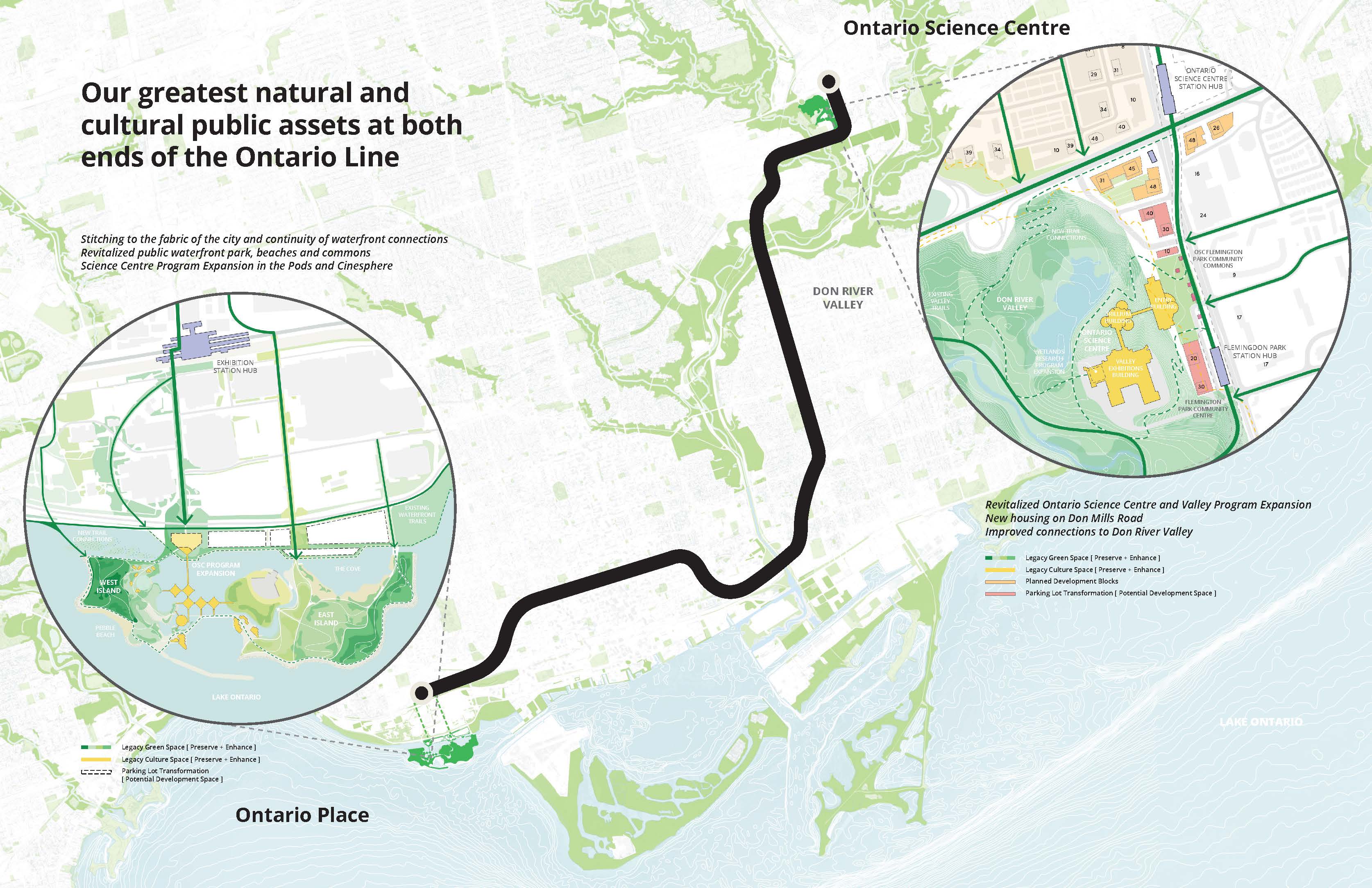
Our proposal builds on many good ideas that have already emerged and attracted advocates. It starts from the recognition that both Ontario Place and the Ontario Science Centre, designed and built to celebrate Canada’s Centennial, represent a valuable legacy.
When both were conceived, the provincial government viewed these two remarkable projects as gifts to the people of Ontario. Progressive Conservative Premier John Robarts described Ontario Place as, “a place where people could come, see and reflect upon the society that has been created in Ontario … where we could examine our history, look at our cultural and economic growth and contemplate the challenges of the future.”
Both these landmark institutions are still important to the people of Ontario. Both were designed by two of the country’s finest architects at the time — Eb Zeidler at Ontario Place and Raymond Moriyama at the Science Centre. Their work was bold; it reflected the social, cultural and economic transformation of the 1950s and 1960s. It was a new era in architecture and both these projects were innovative and well-received. The Ontario Science Centre, one of the first interactive science museums in the world, has welcomed and inspired generations of schoolchildren since its opening.
We believe that after years of neglect, it’s time to honour the value of these institutions, not to destroy them. As with all cultural institutions, their mandate to the public is to build on history and reinvigorate programming to “contemplate the challenges of the future”. That requires government support. During the pandemic, our city parks were overrun with people. COVID-19 was a stark reminder of how public greenspaces, valleys and ravines and the waterfront, are critical to people’s health and well-being. This is our public trust. This is for our common good.
We don’t believe that these lands are there to be used for private profit at taxpayers’ expense. While there is a role for private enterprise, our democracy has a deep-rooted tradition of robust public consultation and transparency. Working together.
Plans for a $350 million private sector pay-for-use spa under 95-year lease signed behind closed doors do not meet these public objectives. Nor do current plans to chop down 850 trees at Ontario Place and pay $400 million of taxpayers’ money for a 2,100-space underground parking garage plus additional large payments for site servicing. The terminus station of the Ontario Line will be within walking distance, so why would taxpayers pay for more traffic and congestion?
We have not seen evidence that anyone in Ontario asked for a MegaSpa on our waterfront land. We did not see a groundswell of demand to destroy the Ontario Science Centre. It would be bad for Toronto, for Ontario and the planet. In terms of greenhouse gas emissions alone — demolishing the Science Centre would create roughly the carbon footprint of 50,000 people flying from Toronto to London, England — all to destroy an architecturally significant building that is barely 50 years old.
Premier Ford has said: “It’s all about working together”. We’d like to take the premier at his word. Ontario has a wealth of talented and knowledgeable professionals who would gladly work with the provincial government to find a better future for these two institutions, and the people of Ontario.
Premier Ford, talk with us and let’s work together. If ever there was a time to work together for a better future, it is now.
Revitalizing Ontario Place
The Attraction is Here, Now
At Ontario Place the “attraction” is staring us in the face. It is the creative renewal and adaptive re-use of the Pods and the Cinesphere, the remarkable architectural and landscape setting created by the combined talents of architect Eberhard Zeidler, landscape architect Michael Hough and Eric McMillan, the designer of the popular Childrens’ Village.
Ontario Place was created by a Progressive Conservative government spearheaded by premiers John Robarts and Bill Davis, who opened the site in 1971. Inspired by Expo 67 in Montreal it was innovative, exciting, fresh, new and about ONTARIO – our land, our increasingly diverse population, our expertise and talents and a new way of experiencing life and nature and rediscovering Lake Ontario.
Always described as a “Park” by its creators, it was also “serious fun” demonstrating new ways for all ages to be together in public.
The design collaboration, which was a first, was inspired. Zeidler’s pods and Cinesphere (where Imax was invented) were one of the rare built examples in world of a precocious modernism, featuring elegant and spare exposed structure and resting lightly on the land and water. Hough, a pioneer of landscape ecology, came up with ingenious ways of protecting the shoreline by working with nature, making it habitable in the face of wind and wave action. This combination was brilliant and has been recognized by the World Monuments as an icon of mid-20th century modernism.

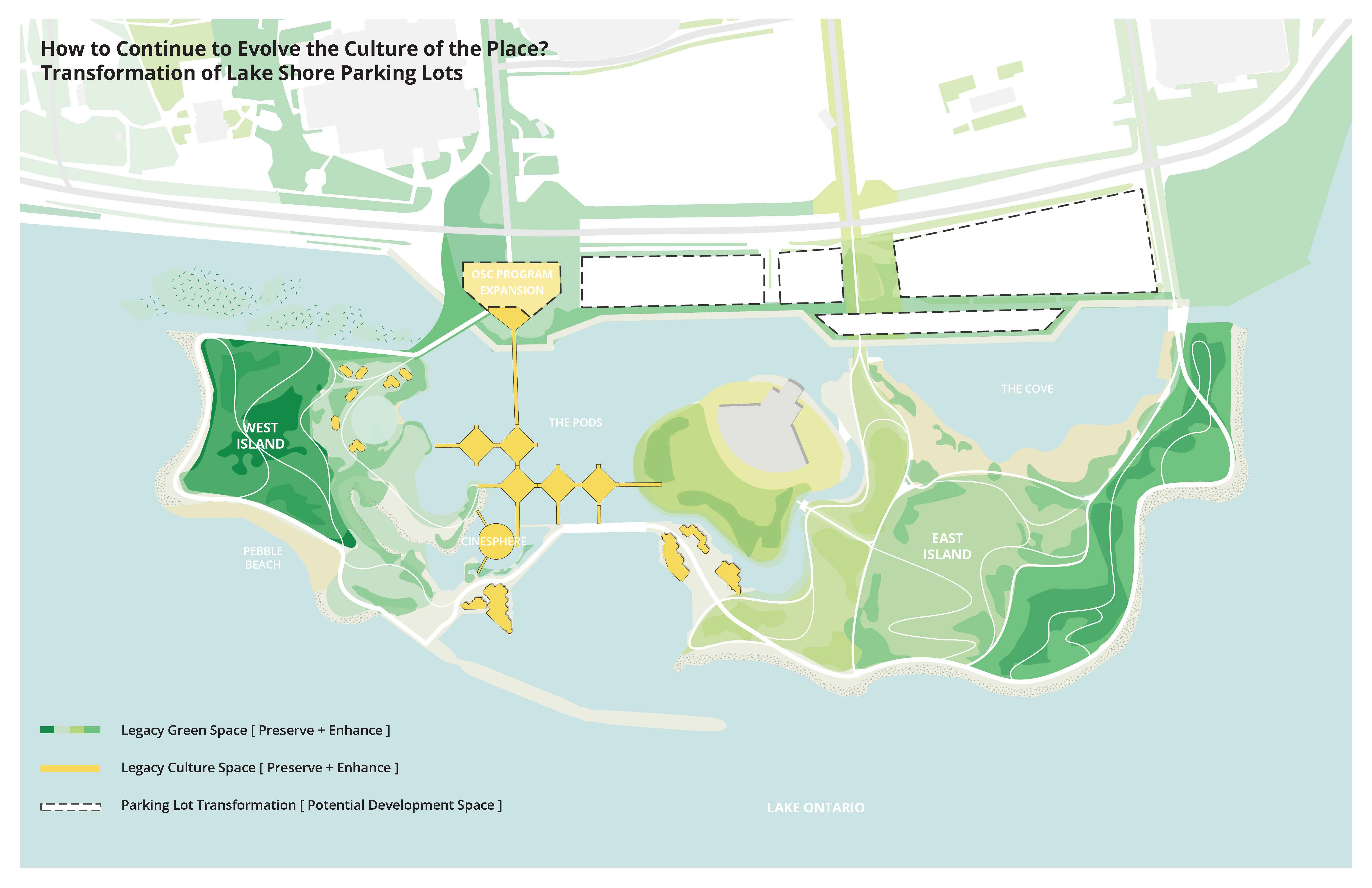

Despite decades of neglect and deferred maintenance, the strong “bones” of the original creation are still in place. What is needed is not a “big bang” erasure for commercial use but a skilful and sensitive renewal and adaptive re-use plan that builds on the great strengths of the site’s remarkable legacy.
Water Science Experience at Ontario Place
We believe that a perfect infusion of new use in the pods and Cinesphere would indeed include participation by the Ontario Science Centre, not as a replacement for the existing facility at Don Mills, but rather as the complementary lakeside branch. This has long been planned by Science Centre staff.
The Ontario Place science experience would focus on water, the natural environment, climate change, doing real science and education. It would connect with the ambitious plans of both the Canadian and United States governments to protect the Great Lakes.
A Park for People
At the same time Ontario Place has also come into its own as a valuable and highly used park in spite of the closure of many of its facilities. During the past three years of pandemic, with virtually no programming it has drawn more than one million visitors a year, year-round. They use Ontario Place for what it was intended to be — a park.
Ontario Place offers visitors respite and relaxation, informal recreation and room gathering. In response to the extraordinary demands on public space in the Greater Toronto Area, it has become an essential part of the connected network of waterfront parkland along the Martin Goodman Trail, serving the fastest growing population in North America. For the vast number of us who do not have cottages, our waterfront has become our resort in the city. And for visitors, both local, national and international our waterfront has become a highly attractive must-see destination.
Trillium Park — Already an Ontario Place Success
The wonderful new 7.5-acre Trillium Park is proof of concept. It is popular, well-attended and much loved. Building on what has already been accomplished there on the eastern edge of Ontario Place, we want to continue to expand on Michael Hough’s legacy landscape and landforms. We see this level and quality of treatment extending across the entire site including the 13.5-acre West Island as a great park extension, removing some of the structures, preserving the 50-year-old trees and introducing new park uses and users to complement the repurposing of the pods and the Cinesphere.
We believe this improved West Island parkland could, like Trillium Park, be created with indigenous participation, celebrating biodiversity, with active and passive park uses and public amenities. Let’s bring back — in renewed form — the Ontario Place Public Common. with restaurants, cafes, informal outdoor performance areas and a place to be on the water, to swim and touch the water.
We envision a comprehensive yet straightforward program to better connect the West Island and integrate it with the larger Ontario Place site. Our idea includes:
· A branch of the Martin Goodman Trail hugging the water’s edge and making its way around the perimeter of Ontario Place
· A generous new land bridge overcoming the barrier of Lakeshore Boulevard and connecting to Exhibition Place
· Improved entry to the pods for the Ontario Place Exhibits presented by the Science Centre
· A robust connection to the intermodal Ex Place/Liberty Village Station for the Ontario Line
all-day GO service and the 509 Waterfront LRT and Celebration Square planned for FIFA in 2025.
Many of these ideas are already in discussion but not budgeted for. They can be achieved at a combined cost that would be a small fraction of what has been proposed as public funding for a massive underground/underwater parking garage to accommodate the Therme MegaSpa.
Cost and Feasibility
We have done a high-level cost comparison for the West Island. We believe the work could be done for a fraction of the cost of the MegaSpa scheme by resourcefully using what we have – land and buildings, providing real value for taxpayer dollars.
‘Ontario Place is 80 acres of prime, public waterfront land. The Therme Spa scheme proposes a twelve-acre private structure and grounds which essentially fill the West Island, requiring the felling of 850 mature trees. Just under ten acres of the lake is proposed to be filled in to compensate for the loss of public land and repair public connectivity, yet still causing a net loss of public space as compared to the island today. And with $650m allocated to providing an underground garage plus site preparation and lakefill, this net loss of space comes at a premium cost to taxpayers.
Alternatively, the West Island can be transformed into a much needed and improved public park. Leveraging the stunning existing mature tree canopy, this transformed public waterfront park can be achieved at significantly less cost, estimated at approximately $70m based on an extrapolation with inflation from the costs for Trillium Park. Better still, it would avoid landfill operations which carry significant potential for cost overruns, and result in more acres of publicly accessible open space than the spa scheme.’
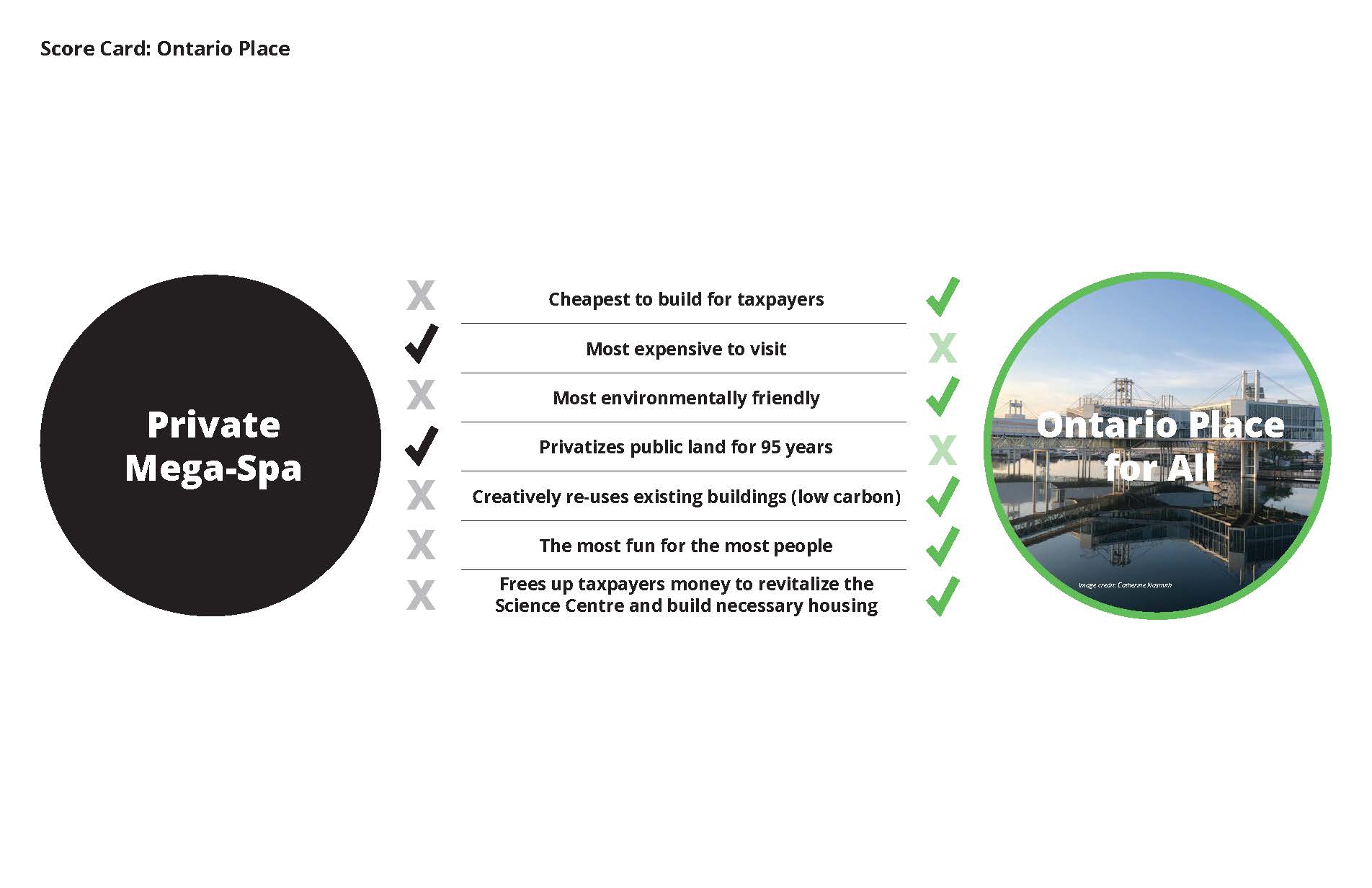
Economic benefits
Ontario Place for All commissioned a study from highly reputed financial analysts HR&A in 2019. The question we posed was – Where is the greatest return on investment for the public with the renewal of Ontario Place? The findings were clear based on a vast survey of their work in international settings:
· Toronto’s waterfronts are economic engines that are inextricably linked to the identity and vitality of the city.
· Forward-thinking cities across North America are actively investing in public space and reclaiming their waterfront assets for public use.
· This trend is also occurring in international cities that are trying to maintain or reinvent their image as vibrant waterfront communities.
· These investments in high-quality public waterfront assets are driven by two primary motivations: LONGEVITY OF BENEFITS The long-term, enduring nature of benefits that stem from high-quality public spaces. DIVERSITY OF BENEFITS The diverse variety of community benefits generated by high-quality public spaces.
· High quality public spaces are unique because their investment horizon is much longer than any commercial use.
· When compared to public space uses, commercial uses will typically create short-term improvements but at the expense of long-term, enduring benefits.
· Another motivation for investing in high quality public spaces is their ability to create significant and measurable benefits for their respective regions.
· Real Estate benefits; tourism benefits, social cultural benefits, talent benefits
· Public spaces increase the value of adjacent properties, accelerate the volume of development, and serve as orienting anchors for new growth.
· Given its location, Ontario Place will have significant real estate implications on Exhibition Place and diminished public space will impact its value creation potential.
· Well-designed public spaces become regional destinations that catalyze tourism and create incremental spending in the local economy.
· A rich portfolio of public spaces can enhance a community’s population health, public safety, social cohesion, and overall quality of life.
· Workers are flocking to cities that offer amenity rich lifestyles and employers are locating in areas where they can attract and retain this talent.
· Since Toronto’s waterfront revitalization began, the region has become an increasingly competitive economic market and entered the upper echelon of global tech capitals.
· Preserving public space at Ontario Place, a critical link in Toronto’s waterfront network, is a strategic investment in the city, its economy, and its communities that will last for generations to come.
When we think of the enduring value of great parks, we think of Central Park in New York City, Golden Gate San Park in San Francisco, the Jardin du Luxembourg in Paris, Chapultepec Park in Mexico City and Millennium Park in Chicago. Our genius loci (genius of place) is our emerging magnificent “GREAT WATERFRONT PARK”, the multi-generational, all hands-on-deck creation of continuous shoreline park system for millions of Ontarians and visitors From Coots Paradise in Hamilton to the Scarborough Bluffs and beyond and Ontario Place is a major jewel in the string of pearls that forms it.
Project Delivery
It turns out we have the mechanism in place to implement this plan at Ontario Place. Waterfront Toronto, created in 2001 and supported by three levels of government, was designed for the Province, the City and the Federal government to work together. With a 22-year track record of creating outstanding public spaces it is one of the best multi-lateral agencies of its kind in the world. Its Designated Waterfront Area includes Ontario Place, and it has already established a precedent for involvement here. Trillium Park was the result an Infrastructure Ontario and Waterfront Toronto collaboration. One of the particular strengths of Waterfront Toronto has been its broad appeal to multiple constituencies and its success in building the kind of consensus that is needed n this case through meaningful consultation. Another of its hallmarks has been the use of invited design competitions to achieve design excellence which could be deployed.
At the other end of the Ontario Line, The Ontario Science Centre
Like many others we believe that the idea of moving the Ontario Science is a bad idea on so many levels:
· 50 years ago we recognized the value of ‘dispersal’ not having all good one of a kind things downtown – that idea is still valid
· The communities of Flemington Park and Thorncliffe Park have developed strong meaningful relationships with the Ontario Science Centre
· The Science Centre is no longer isolated; it is now already at the heart of a rapidly growing transit-oriented community at Don Mills and Eglinton
· The Ontario Line and Crosstown LRT arrive right there, serving the new Science Centre Station
· The other corners are intensifying bringing many tens of thousands of new residents
· The land, the 81 acres of Conservation Authority land the Science Centre sits on in the Don Valley has a unique relationship with the Science Centre and it was designed to take advantage of that relationship
· The Conservation Authority will not allow these “hazard lands” to be developed and rightly so, the lessons of Hurricane Hazel
· Preserving the architectural legacy of Raymond Moriyama’s work; we should not ‘trash’ this important building, sabotaging the Progressive Conservative Party’s own Centennial legacy
· Preserving the enormous amount of embodied energy in this still useful building versus the wasteful impulse of a thruway society; it was designed to last for over 250 years with proper maintenance
· There is plenty of room to build more affordable housing on the ‘uplands’ in the parking lots on Don Mills Road without sacrificing the Science Centre
· The proposed replacement Science Centre at Ontario Place would be less than half the size of the current Centre with awkward access
· It would look and feel like an odd appendage or “saddle bag” dwarfed by its immediate adjacency to the gigantic Therme MegaSpa

Toronto is the city of ravines, and the design of the Science Centre capitalizes on this spirit of place as the backdrop for every visitor’s entry and exit experience. By gently descending into the natural beauty of the valley, Raymond Moriyama is reminding us that science is the very exploration of nature itself.
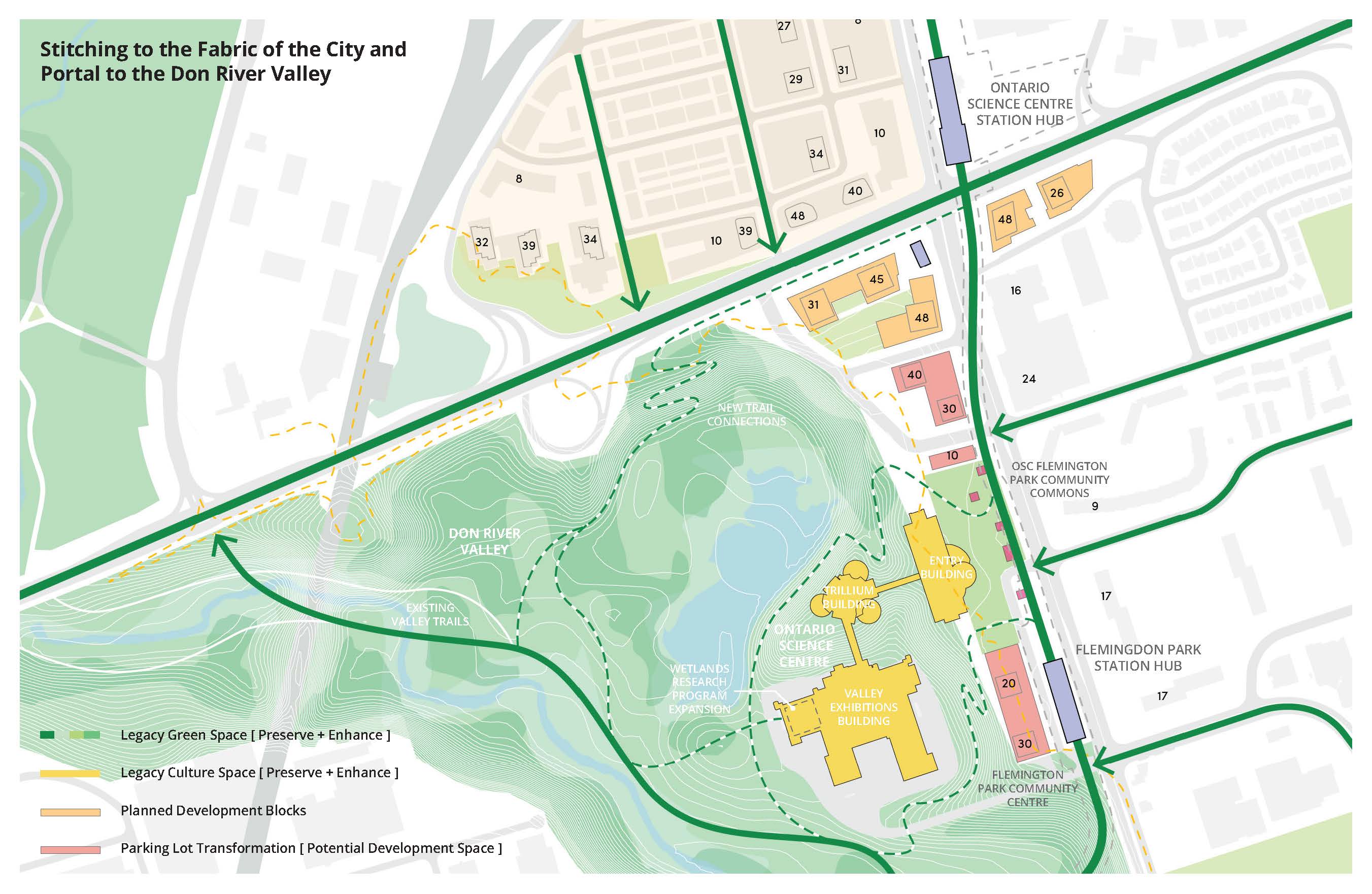
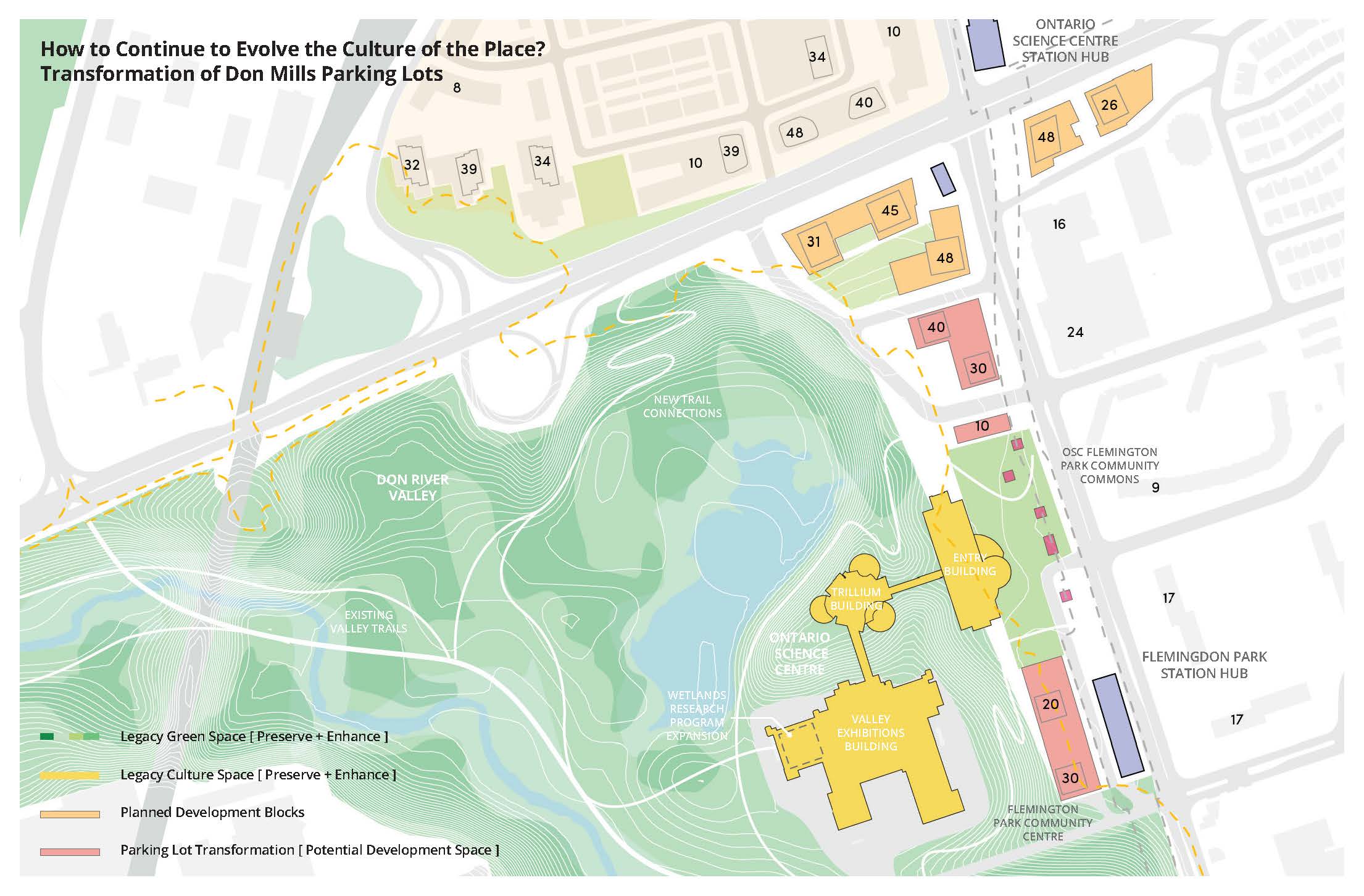
The Ontario Science Centre should evolve its vitality with a renewed mandate, programs related to its unique site – such as perhaps a wetlands research institute, reaching out and connecting to the existing wetlands area just north of the Science Centre’s valley exhibitions building. At the top of the ravine, in front of the entry building on Don Mills, we imagine an enhanced “OSC/Flemingdon Commons” park space that is a natural outdoor landing for the soon to come Flemingdon Park stop of the Ontario Line. A new and enhanced front plaza to the Science Centre, with community use spaces and commercial pavilions, all servicing the adjacent community of Flemington Park and Don Mills.
To the immediate north and south of this Commons, There is plenty of room for new housing while preserving the Science Centre at the heart of this growing community. In fact, the only area where housing can actually be built safely in this area is on the parking lots along Don Mills Road, outside the hazard lands owned and protected by the Conservation Authority, not touching the footprint of the Science Centre itself. With the coming Ontario line, there is a reduced need for these large parking lots, built for a different age, so they can safely be downsized and partly placed underground.
From the new OSC/Flemingdon Commons, we also see great value in creating a valley trail that loops and encircles the Science Centre, providing pedestrian access down into the valley and wetlands below, linking to the existing trail networks already in place. This is a well needed linkage for all the tableland housing developments above, and providing access for hiking, biking, walking, commuting, and the general appreciation of Torontos most unique natural treasures – its ravines.
Adding Housing
The City of Toronto owns a strip of available lands currently used for surface parking on Don Mills Road. These parking lots on table land with a combined area of approximately 5.2 acres (2.1 hectares) can be used for mixed-use, mixed-income development. They could comfortably accommodate 1000 housing units for some 2000 people plus some employment and other neighbourhood uses and amenities. A target for a percentage of affordable units could be set at say 30 percent could produce 300 units.
We see this additional neighbourhood development as a highly desirable complement to an improved renewed Ontario Science Centre with new programs related to the Don Valley Park system and connected to the massive Transit Oriented Community development already underway for some 25-30 thousand new people plus jobs surrounding the new Eglington Crosstown LRT/Ontario Line subway station. Far from being an impediment to new housing demands of the city, we believe the Ontario Science Centre to be a fundamental and essential amenity as an anchor to both this densifying community, and the Ontario Line itself.
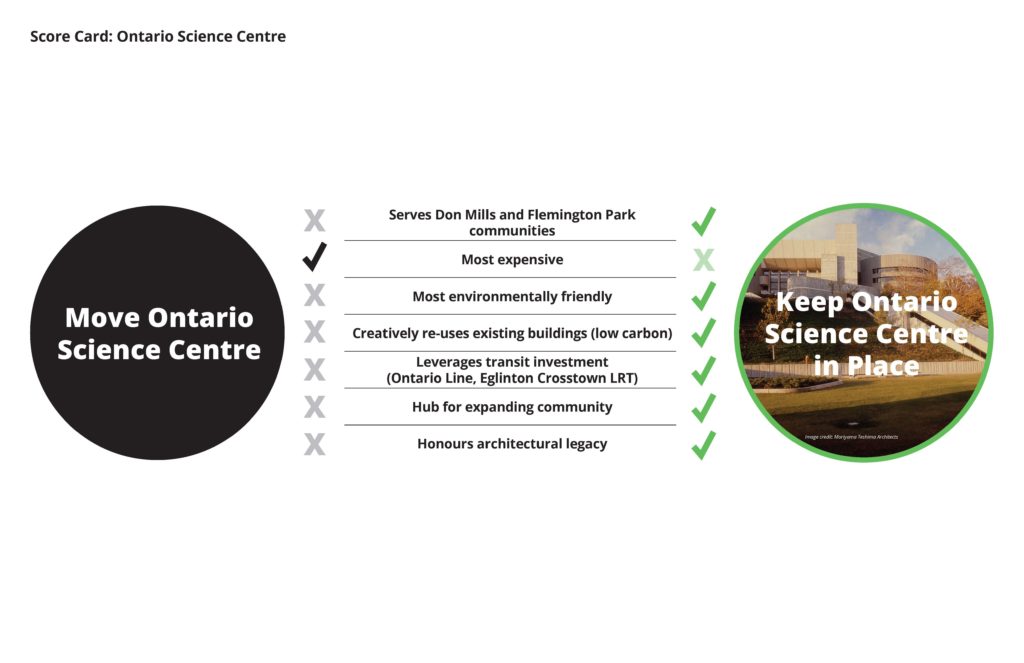
An offer to open the Dialogue
By enlarging our perspective Ontario Place for All is offering what we believe is a Better Idea for the combination of Ontario Place and the Ontario Science Centre. This is still very high-level thinking and needs to be fleshed out but we offer it in in the spirit of breaking out of the narrow confines of the current debate and engaging all parties in a larger conversation about what is possible as we consider what happens next in these two highly sensitive areas of our cultural legacy.
